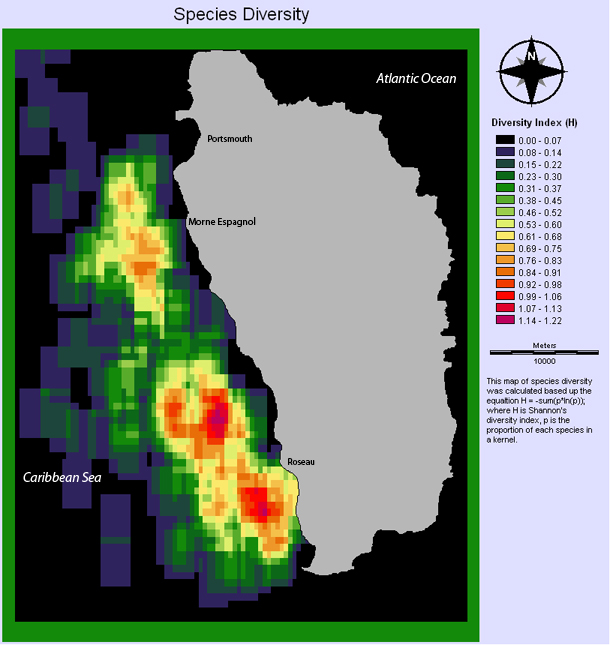Results
Diversity of Cetaceans :
The analysis for species diversity highlights three areas along Dominica's leeward coast. The most southerly hotspot is likely explained by the few sightings of beaked whales which were all in the souther part of the island, as are the majority of the bottlenose dolphin sightings. The large hotspot in the middle of the island coincides with the main area of CW effort (see analysis of CW effort). What is most interesting about this analysis is the third, most northerly, hotspot. It would appear that a number of species consder the area offshore of Morne Espagnol good habitat. With very little CW effort in that area, this could be an area of interests for the development of protected cetacean habitat.
There are no previous estimates of the Shannon Index for Dominica with which to compare our maximum estimate of 1.22. However, values of 1.86 (the Marquesas islands, French Poylnesia; Gannier, 2002) and 1.57 (the Society Islands, French Polynesia; Gannier, 2000) have reported for cetaceans around other volcanic islands.
It is clear that the Caribbean is a species rich and diverse area. To improve estimates of abundance and distribution for cetacean species, future research should focus on line transect surveys to standardize research vessel effort. Meanwhile, it is important that all research activity in this area report their opportunistic sightings; so that a better overall picture can be produced through syntheses of these sparse data sets, such as this one. In addition, it can be recommended that the association of cetacean watching operators establish a cetacean sightings database in an effort to document sightings from CW activity which occurs year round. Ideally, all CW operators in the Wider Caribbean would contribute to such a database and analyses could be regularly performed. There is a model for this in the regional Ocean Biogeographic Information System nodes like OBIS-Canada curated by the Centre for Marine Biodiversity and the Bedford Institute of Oceanography. This would greatly facilitate the gathering and sharing of small opportunistic data sets. OBIS is a project of the Census for Marine Life. There is currently no regional OBIS node for the Caribbean region, but the means and documentation are available online for a Caribbean based group to develop a regional OBIS node (OBIS, 2007). The establishment of such a database would be a major step in improving our knowledge of cetacean species in an area where little is currently known. Sighting networks such as these are inexpensive ways of achieving strong datasets on abundance and distribution of cetacean species without major investment of effort or funding by government or the commercial sector.

Figure 3 - Diversity Index highlighting diversity hotspots on the leeward coast
Continue to Results: Location and Intensity of Cetacean Watching Effort
